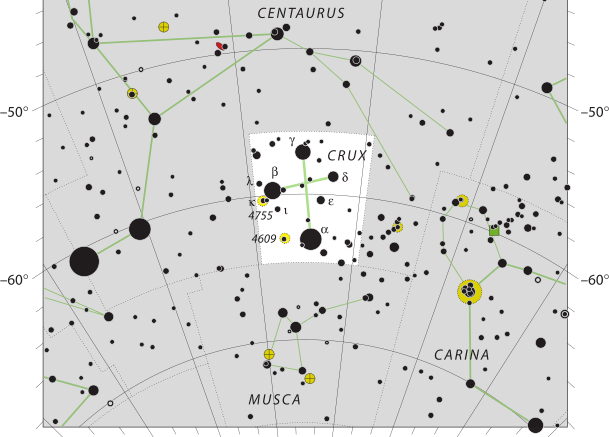Centered on 4 stars a bright portion of the Milky Way in the Southern Hemisphere skies, the constellation Crux is one of the most easily distinguished constellations in the sky. As each of these 4 stars form an asterism, known as the Southern Cross, each have an apparent visual magnitude brighter than +2.8. The constellation is smallest of all 88 modern constellations, with the name Crux being Latin for cross. The amount of night sky that Crux makes up when visible is 0.165%.
| Applicable Information | |
| Visibility In Pacific Northwest | Not visible in Pacific Northwest |
| Best Times To View | Not visible in Pacific Northwest |
| Right Ascension | 12.5h |
| Declination | −60° |
| Area | 68 square degrees |
| Main Stars | 4 |
| Brightest Object | Acrux |
| Meteor showers | Crucids |
| Messier objects | 0 |
| Neighboring Constellations | Centaurus, Musca |
History
Although the precession of the equinoxes gradually lowered the stars below the European horizon, Crux was visible at one point in time by the Ancient Greeks. This was 4th century BCE when Europeans last saw the stars as part of their skies.
Historians generally credit João Faras for being the first European to depict it correctly. Faras sketched and described the constellation in a letter written on the beaches of Brazil on 1 May 1500 to the Portuguese monarch.
There were several explorers who would write about or describe the features of the constellation during the 1500s.
The first sky mappers to properly distinguish Crux as a separate constellation was in 1592. Although placed in the wrong position until 1598, Crux had been identified. Its stars were first catalogued separately from Centaurus by Frederick de Houtman in 1603 and Crux was later adopted by Jakob Bartsch in 1624 and Augustin Royer in 1679.
Stars
Within the constellation’s borders, there are 49 stars brighter than or equal to apparent magnitude 6.5. The four main stars that form the Southern Cross asterism are Alpha, Beta, Gamma, and Delta Crucis.
Crux contains many variable stars. It boasts four Cepheid variables that may all reach naked eye visibility, which include:
- The Coalsack Nebula, which is partially in Crux and neighboring constellations is the most prominent dark nebula in the skies. The nebula is easily visible to the naked eye as a prominent dark patch in the southern Milky Way.
- A key feature is the Jewel Box, otherwise known as NGC 4755, is a small but bright open cluster that appears as a fuzzy star to the naked eye and cn be found is very close to the westernmost boundary of Crux.
Make sure to check out other articles on the site, including a brief introduction to constellations, other constellation articles, and more!

Be the first to comment on "Crux"